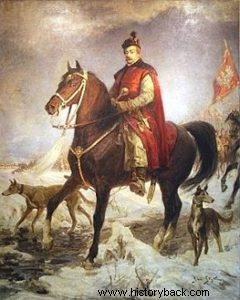
At the beginning of 1595 the ruler of Transylvania, Sigismund Bathory, caused a revolution against the Moldavian prince Aaron the Tyrant. Aaron was captured by his mercenaries and sent as a "gift" to Bathory.
Aaron, however, was a subordinate and protégé of the Turks, who naturally reacted immediately. Sultan Mehmet III decided to put an end to the conflicts of the rulers of Moldavia, Wallachia and Transylvania by force of arms. The sultan's plan was to incorporate Moldavia into his state and install a man of his own on the throne of Wallachia.
However, such a development was not at all pleasant for Poland (Polish-Lithuanian Commonwealth) which did not wish for the strengthening of the Turks on its southern border. Also the Poles wanted to regain their lost influence in the region, influence they had lost about 100 years earlier.
Thus in the summer of 1595 a small Polish force of 5,000 cavalry, 2,300 infantry and some light artillery under General Jan Zamoyski invaded Moldavia. On August 27, the Poles occupied Hotin and on September 3, the capital Iasi.
Zamoiski then imposed Jeremiah Movila on the throne, attempting to create a friendly shield state against the Turks and their Tatar allies.
Polish moves could not go unanswered by the Turks. So Sultan Mehmet asked the Tatar ruler Gazi Girai Khan to attack the Poles in Moldavia. He even reinforced him with regular Ottoman troops. In total the Islamic army numbered over 25,000 men, outnumbering the Poles more than 3:1.
Battle at the fortified camp
In the meantime Zamoyski learning that the Muslim army was approaching crossed the river Prutus with his small army and encamped in a location where he had both sides covered. There on September 6 he created a fortified camp and awaited the enemies. The Polish camp was well fortified. It had 13 bastions and four gates for making exits.
On September 18 the Muslim army appeared before the Polish fortified camp and soon the first shots were exchanged. The next day Gazi Girai Khan attacked with all his forces. The arrows of the Tatars covered the sky, but the Poles faced them with courage and heavy fire...
The Tatars had many cavalry but few infantry. So their raids were not successful. However, even when they threw dismounted horsemen into battle, they still did not manage to capture the Polish fortress. On the contrary, the Poles, with small, highly successful sorties, harassed them in particular and caused them heavy losses.
The battle continued the next day in the same manner. The Tatars and Turks persisted, the Poles endured and the dead piled up before the ramparts. Disappointed, Gazi Girai Khan ordered a halt to the attacks and even requested talks with Zamoiski.
The Polish general accepted and the next day the talks resulted in an agreement. The agreement was particularly favorable to the victorious Poles. The defeated Gazi Khan recognized Movila as the ruler of Moldavia and also recognized the right of the Poles to maintain a garrison in Moldavia. On September 23 the humiliated Muslim army withdrew.

The Polish General Jan Zamoyski.
